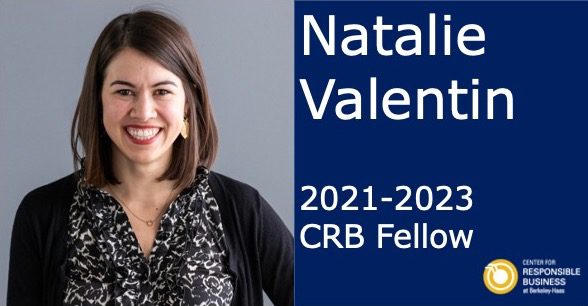Alumni Perspectives From the Front Line of Impact Investing

By Deborah Fleischer, CRB Communications Consultant, and Christina Meinberg, CRB Associate Director. This is the first in a series of blog posts highlighting CRB alumni. In this post we focus on Margot Kane, MBA ’08.
According to a recent article in Forbes, impact investing is gaining momentum but has not yet taken off. If Margot Kane, Haas MBA ’08, Director of Strategic Initiatives at Calvert Social Investment Foundation (Calvert Foundation), has her way, impact investing will hit the mainstream soon.
Kane takes a big picture, broad perspective on the term: “Impact investing is investing for a return, in line with prudent financial standards, in projects, organizations, and assets that substantially improve the lives of communities, traditionally in under-served areas and communities.” She adds, “It is bringing a slightly different set of calculations to your investment decisions.”
Linking Values with Investments
At Calvert Foundation, Kane is responsible for starting up new investment initiatives that link a group of interested investors to a portfolio around an organizing impact theme. The unique value of Calvert Foundation’s platform is their Community Investment Note™, a widely available security that people throughout the U.S. can invest in for as little as $20. The debt capital raised from private investors enables Calvert Foundation to invest in projects and organizations in the communities that investors care about to improve economic opportunity and living conditions in underserved communities.
To date, everyday people have no legal means of directly investing in such projects for an obligated return of principal and interest, although new crowdfunding regulations should open up more opportunity in this direction. “We realized that our platform is a good tool for engaging investors that increasingly want to support their values with their investments,” explains Kane. Over the past 17 years, Calvert Foundation has raised nearly $1 billion dollars from investors in this Note, and to date, every investor has been repaid.
Kane’s team launched the Women Investing in Women Initiative (WIN-WIN) in March 2012, which offers investors a way to invest in women through healthcare, microfinance and education. WIN-WIN has invested more than $10 million in organizations empowering women. A local Bay Area example is Girls Inc., a program for at-risk girls operating in Alameda County. Northern California Community Loan Fund, a longtime partner of Calvert Foundation, wanted to finance a new building for Girls Inc. in Oakland, and they needed a financing partner to provide $1.5 million to close on the project.
The transit-oriented development near Bay Area Rapid Transit (BART) would make it easier for girls to access the programs, and the larger space provided an opportunity to serve more girls. Kane explains that commercial lenders generally don’t fund this kind of project due to location, potentially lower yields, and higher risk or higher perceived risk; this makes it a perfect opportunity for an impact investor.
Location. Location. Location
Kane explains that the commercial arm of a bank is often resistant to doing deals in low-income neighborhoods with a non-profit borrower. This is due to a range of reasons–because the loan-to-value doesn’t pencil out, the collateral value is disputed or cash flows are too uncertain.
On the other hand, the Community Reinvestment Act (CRA) mandates that banks invest in low-income communities where they have depositors. Therefore, banks have community investment practices that actively seek out higher risk deals in these communities. However, banks are rigidly geographically limited to specific census tracks. If a project falls outside of a designated CRA neighborhood, it won’t qualify for CRA credit.
Investing in Communities
Kane is excited about providing people opportunities to invest in their community on issues they care about the most deeply. In addition to her focus on women, she is also currently building a new program about engaging diasporas in the United States to invest in their countries of origin, and working to launch an Iconic Places initiative, a place-based Community Investment Note that will provide opportunities for people to invest in specific projects in culturally and historically significant cities and regions of the U.S., such as Detroit or Appalachia.
Kane is a 2013 PLACES Fellow with the Funders’ Network for Smart Growth and Livable Communities, which provides intensive place-based learning tours, exposing Fellows to on-the-ground examples of how communities and regions are integrating the principles of equity into their growth and development plans.
According to Kane, the Fellows program pushes participants to think through equitable smart growth and explore place-based development and funding strategies that take into account minority communities’ rights and needs.
Emerging Trend: Grassroots Engagement
Kane points out that Calvert Foundation is in the middle of a key transition, moving from a place where they primarily courted institutional investors and financial advisors (because they were the gatekeepers for larger amounts of capital), to reaching out to individuals to invest in the Community Investment Note. “This transition to grassroots engagement is probably what I am most excited about and feel will be our greatest accomplishment,” explains Kane.
Currently, most people can participate in Calvert Foundation’s notes through an online broker-dealer, Microplace, starting as low as a $20 investment. Participants don’t need to be accredited investors or high net worth individuals to participate. Notes can be purchased through a financial advisor or directly from the Calvert Foundation.
“One of the things we are working on is democratizing impact investing, getting it out of the wealthy civic-minded minority and into the hands of the majority. The challenge is that many people don’t consider themselves investors because they aren’t wealthy. What they don’t realize is if you have a bank account or a 401(k), you are an investor,” stresses Kane.
To amplify this trend toward democratizing impact investing, Calvert Foundation is developing cutting-edge on-line strategies, technology and data to engage individuals as investors. She points to the examples of 270 Strategies and Purpose, consulting practices started by seasoned campaign organizers now applying their approach to other social causes, as inspiration for this direction.
She emphasizes, “People have more investment assets than charitable assets. The more you can get people thinking about investing in line with their values, the more leverage you have. A lot of small changes can make a big difference when everyone is investing with shared objectives.”
Challenges and Advice for Students
One of Kane’s professional challenges is how to articulate a shared vision and manage complex partnerships to get everyone on the same page. She works at listening to others, understanding their perspectives, building trust and being transparent with objectives.
The Haas School of Business gave Kane a practical set of skills and understanding of economics and finance, as well as strategy and leadership skills, which helped her enter the field of social finance. She was part of the inaugural portfolio management team for the Haas Socially Responsible Investment Fund (HSRIF) that devised the Fund’s operational governance practices and social investment strategy, providing her hands-on, real world social investment experience. “The breadth of experiential projects I had at Haas, most notably through the Center for Responsible Business (CRB), really helped me figure out what kinds of roles I wanted to play in my chosen industry. From setting up a student-run Socially Responsible Investment Fund to co-chairing the Global Social Venture Competition to consulting to corporate clients on sustainability programs.”
As for advice to MBA students interested in a career in sustainability, “Don’t get too focused on content, also focus on function. Get as much operational experience in the nuts and bolts of the business you care about as possible. If you are interested in sustainable supply chains, you also need to understand current supply chain operations so you can access the real levers of change.”
The other alternative Kane recommends is to take on the entrepreneurial, scrappy role of being a driver of a disruptive business approach (like impact investing) that creates new products and new demand that change markets. While not an easy path, you get to work with incredible, passionate people while making a difference.


